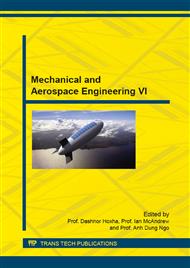p.556
p.565
p.571
p.576
p.582
p.589
p.596
p.602
p.609
Actuation System Design for a Morphing Aileron
Abstract:
In the field of European and International morphing structures projects, the CRIAQ MD0-505 enables collaboration among Italian and Canadian research centers and industries paying particular attention to the development of innovative design in the area of adaptive technologies. The main project goals involve the design of a wing trailing edge device capable to improve aerodynamic efficiency in all the flight envelope leading to fuel consumption reduction with positive impact on aircraft weight. This paper deals with the design and modeling of a novel actuation system of a full scale morphing aileron for a regional aircraft wing. The proposed aileron architecture is characterized by segmented adaptive ribs. Each rib is composed of two movable blocks connected by means of rotational hinges in which are housed bearings and bushing in a finger-like mechanism. Rib actuation is guaranteed by an actuation system composed of a dedicated kinematic chain derived from a quick-return mechanism. In order to achieve the aileron target shapes, the system is driven by a set of servo-rotary electro mechanical actuators that permit a highly integrated design which lay the groundwork for the technological transition from the torque shaft to the distributed actuation architecture.
Info:
Periodical:
Pages:
582-588
Citation:
Online since:
October 2015
Authors:
Keywords:
Price:
Сopyright:
© 2015 Trans Tech Publications Ltd. All Rights Reserved
Share:
Citation:


